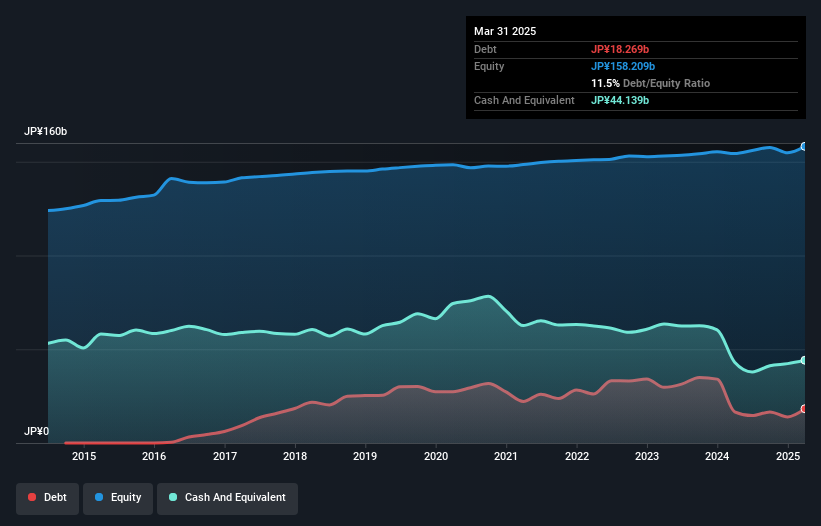The external fund manager backed by Berkshire Hathaway’s Charlie Munger, Li Lu, makes no bones about it when he says ‘The biggest investment risk is not the volatility of prices, but whether you will suffer a permanent loss of capital.’ So it might be obvious that you need to consider debt, when you think about how risky any given stock is, because too much debt can sink a company. Importantly, Osaka Steel Co., Ltd. (TSE:5449) does carry debt. But the more important question is: how much risk is that debt creating?
This technology could replace computers: discover the 20 stocks are working to make quantum computing a reality.
When Is Debt Dangerous?
Generally speaking, debt only becomes a real problem when a company can’t easily pay it off, either by raising capital or with its own cash flow. In the worst case scenario, a company can go bankrupt if it cannot pay its creditors. While that is not too common, we often do see indebted companies permanently diluting shareholders because lenders force them to raise capital at a distressed price. By replacing dilution, though, debt can be an extremely good tool for businesses that need capital to invest in growth at high rates of return. When we think about a company’s use of debt, we first look at cash and debt together.
What Is Osaka Steel’s Net Debt?
The image below, which you can click on for greater detail, shows that at March 2025 Osaka Steel had debt of JP¥18.3b, up from JP¥16.7b in one year. However, it does have JP¥44.1b in cash offsetting this, leading to net cash of JP¥25.9b.
 TSE:5449 Debt to Equity History May 19th 2025 How Healthy Is Osaka Steel’s Balance Sheet?
TSE:5449 Debt to Equity History May 19th 2025 How Healthy Is Osaka Steel’s Balance Sheet?
Zooming in on the latest balance sheet data, we can see that Osaka Steel had liabilities of JP¥40.4b due within 12 months and liabilities of JP¥4.90b due beyond that. On the other hand, it had cash of JP¥44.1b and JP¥33.0b worth of receivables due within a year. So it actually has JP¥31.9b more liquid assets than total liabilities.
This luscious liquidity implies that Osaka Steel’s balance sheet is sturdy like a giant sequoia tree. With this in mind one could posit that its balance sheet means the company is able to handle some adversity. Simply put, the fact that Osaka Steel has more cash than debt is arguably a good indication that it can manage its debt safely.
View our latest analysis for Osaka Steel
The modesty of its debt load may become crucial for Osaka Steel if management cannot prevent a repeat of the 24% cut to EBIT over the last year. Falling earnings (if the trend continues) could eventually make even modest debt quite risky. When analysing debt levels, the balance sheet is the obvious place to start. But you can’t view debt in total isolation; since Osaka Steel will need earnings to service that debt. So if you’re keen to discover more about its earnings, it might be worth checking out this graph of its long term earnings trend.
Finally, while the tax-man may adore accounting profits, lenders only accept cold hard cash. While Osaka Steel has net cash on its balance sheet, it’s still worth taking a look at its ability to convert earnings before interest and tax (EBIT) to free cash flow, to help us understand how quickly it is building (or eroding) that cash balance. Considering the last three years, Osaka Steel actually recorded a cash outflow, overall. Debt is far more risky for companies with unreliable free cash flow, so shareholders should be hoping that the past expenditure will produce free cash flow in the future.
Summing Up
While it is always sensible to investigate a company’s debt, in this case Osaka Steel has JP¥25.9b in net cash and a decent-looking balance sheet. So we don’t have any problem with Osaka Steel’s use of debt. When analysing debt levels, the balance sheet is the obvious place to start. But ultimately, every company can contain risks that exist outside of the balance sheet. Be aware that Osaka Steel is showing 1 warning sign in our investment analysis , you should know about…
At the end of the day, it’s often better to focus on companies that are free from net debt. You can access our special list of such companies (all with a track record of profit growth). It’s free.
New: AI Stock Screener & Alerts
Our new AI Stock Screener scans the market every day to uncover opportunities.
• Dividend Powerhouses (3%+ Yield)
• Undervalued Small Caps with Insider Buying
• High growth Tech and AI Companies
Or build your own from over 50 metrics.
Explore Now for Free
Have feedback on this article? Concerned about the content? Get in touch with us directly. Alternatively, email editorial-team (at) simplywallst.com.
This article by Simply Wall St is general in nature. We provide commentary based on historical data and analyst forecasts only using an unbiased methodology and our articles are not intended to be financial advice. It does not constitute a recommendation to buy or sell any stock, and does not take account of your objectives, or your financial situation. We aim to bring you long-term focused analysis driven by fundamental data. Note that our analysis may not factor in the latest price-sensitive company announcements or qualitative material. Simply Wall St has no position in any stocks mentioned.


AloJapan.com